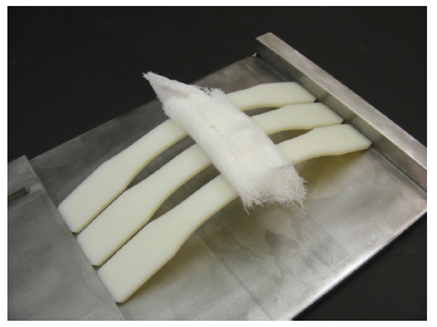This article was originally authored by Jake Nemec.
When plastic parts are designed and manufactured, great effort is placed into producing a part with optimal mechanical, physical, and aesthetic properties. Additionally, considerations are made to ensure that the part will be able to adequately perform in the intended environment for its anticipated lifetime without a dramatic reduction in these properties. In almost all applications, plastic parts are exposed to some form of external or internal chemical agent. This could range from hand lotion to fuel to water to numerous other substances. For a plastic part to properly function and perform for an extended period of time it must have the ability to withstand these agents. Many chemical agents can be harmful to plastic through a variety of mechanisms, including molecular degradation and environmental stress cracking. During the design and material selection phase, it is critical to understand how a material will respond to the substances it will be exposed to over its useful life.
One of the difficulties in obtaining this understanding is identifying what type of chemicals the part will be exposed to during use. Once the substances are identified the question becomes, “how do I know how they will interact with my material?” The common place to look is chemical resistance tables for the plastic. These tables will provide information on whether cracking develops and/or the mechanical properties decrease when soaked in a variety of chemicals. These tables typically give values of 1 to 5 or “Good” or “Poor.” While this is useful information, many plastic parts will fail from substances listed as “Good” or “Excellent” on these charts. It is simply not enough to consider if a material will crack or lose strength when soaked in a substance.

Figure 1. ESC test fixture.
Plastic parts will often behave in a porous manner with certain substances. If you’ve ever used an inexpensive plastic storage container that had spaghetti sauce or salad dressing in it and you forgot to wash it for a week, you’ve likely seen this behavior. You can scrub and scrub, but it will remain discolored. That’s because the sauce or dressing has permeated between the individual molecules of the plastic and into the plastic container. If this can happen with spaghetti sauce or salad dressing, imagine how many substances might do this to your material?
Environmental Stress Cracking (ESC) in plastics is a phenomenon based on the simple example above. It is caused by an external substance permeating into the molecular structure of the plastic that interferes with intermolecular forces, making it easier for the individual molecules to slip and slide past each other while the part is in a stressed state. This slow disentanglement can eventually result in crack development and failure. This mechanism is not degradation and does not attack or break down the individual molecular chains. The information in chemical resistance tables is generally based on the evaluation of the effects of molecular degradation. With ESC, the molecules simply disentangle and slide apart in the presence of stress while in contact with the chemical agent. Compatibility tables may not adequately convey this effect on the plastic.

Figure 2. Photomicrograph showing ESC cracking on a test specimen.
Testing conducted to simulate ESC is based on ASTM D543 “Standard Practices for Evaluating the Resistance of Plastics to Chemical Reagents – Practice B. This test method essentially places a sample, usually a tensile or flex bar, in a continuously stressed state using controlled strain levels. There are several test fixtures that can be used for ESC testing, one such setup is shown in Figure A. The setup shown in Figure 1 bends or flexes the specimen, which creates elevated tensile stresses on the outer edge/apex of the bend. The chemical agent is then locally applied to the surface of the specimen at the apex of the bend. This locally exposed area of the sample is periodically inspected for crack development during the lifetime of the test. An example of typical cracking is shown in Figure 2. By using a sample of known dimensions, the strain level can be calculated, and the test fixture can be set to generate the calculated strain value.
Furthermore, with a known modulus for the material the stress level can also be calculated. This can provide a stress at which ESC will occur when the plastic is exposed to certain chemical agents. When coupled with stress levels predicted in a finite element analysis (FEA) of the part, predictions can be made on whether a part will fail from ESC when in contact with chemicals that it anticipated to be exposed to during use.
It should be noted that ESC can occur even when external loads are not applied to the part. Molded-in residual stresses and thermal stresses in the presence of an ESC agent, can also be sufficient to produce cracking. Whether you are hoping to avoid future failures or you are already experiencing failures, ESC testing can be a crucial test during failure analysis of plastic parts and the material selection/design process.
